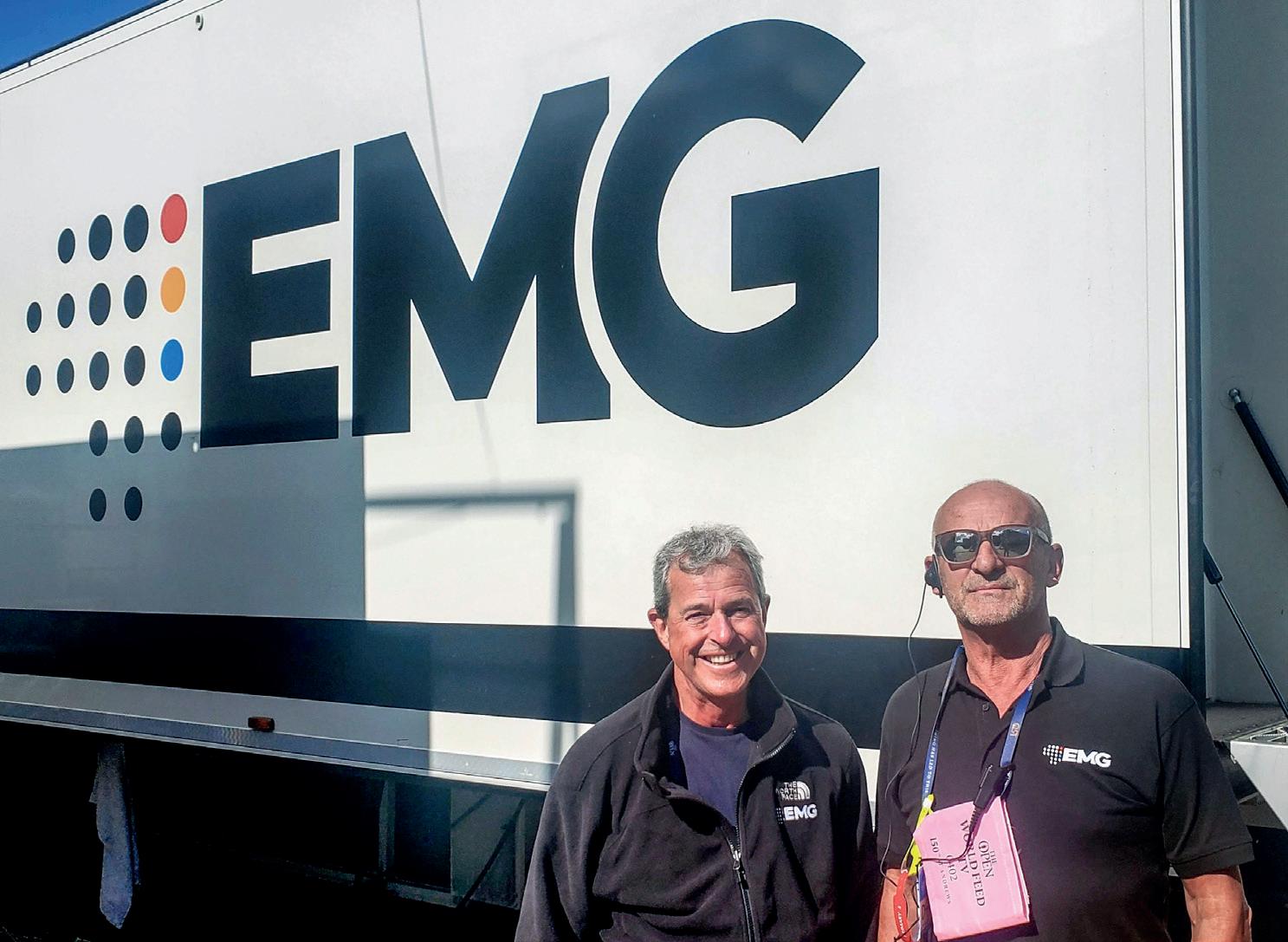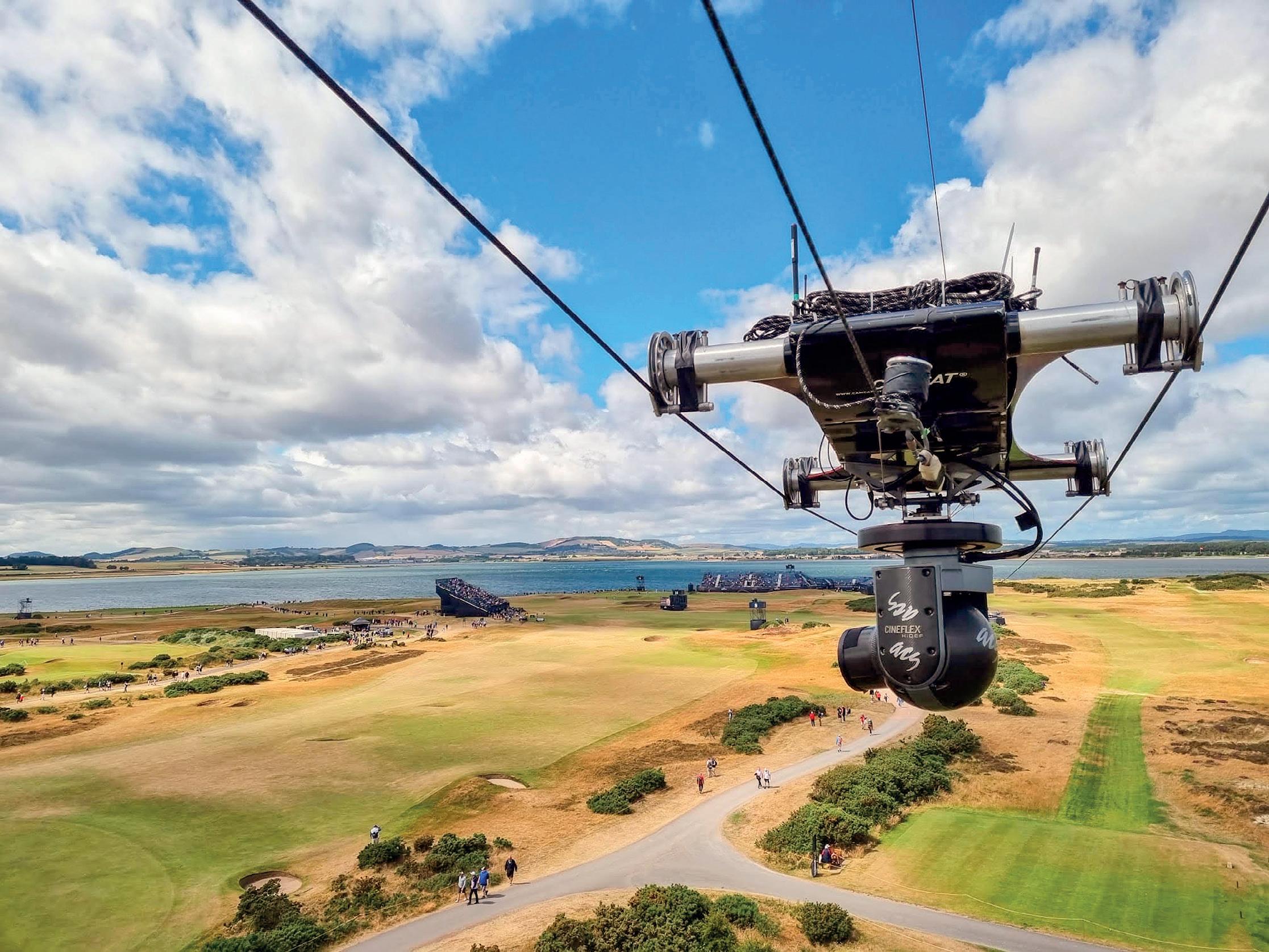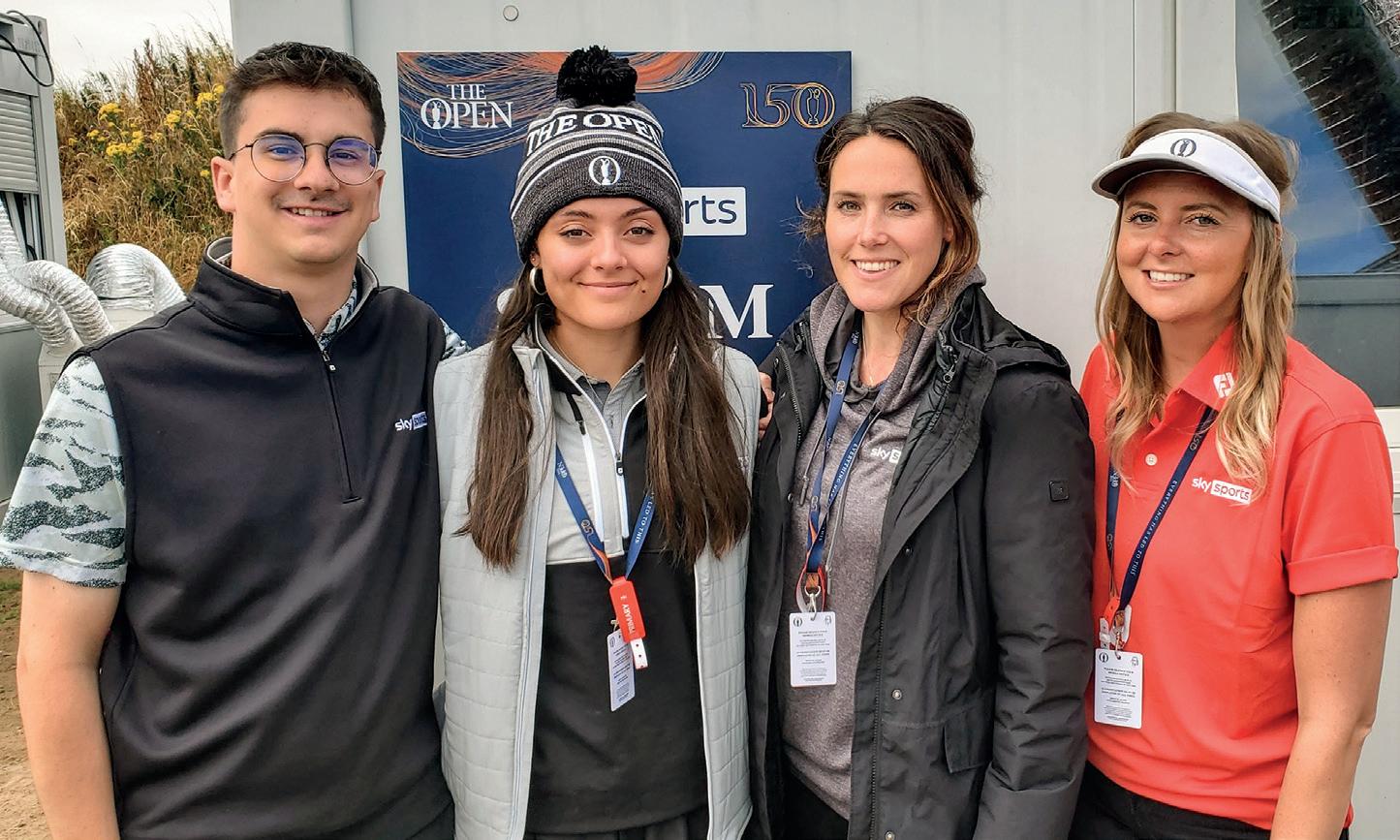
10 minute read
The Open Championship
EMG UK’s Terry James (left) and Hamish Greig at The 150th Open Championship
Live from The Open Championship: EMG UK efforts power world feed, unilateral rightsholder operations
BY KEN KERSCHBAUMER
FIRST PUBLISHED 15 JULY 2022
“T here are a lot of extra toys and extra facilities for the 150th,” says EMG UK deputy CEO Hamish Greig. “On Monday afternoon, there was a Celebration of Champions, and it was a 35-camera show on holes 1, 2, 17, and 18. But it was still a very high-spec show, with all the specialist cameras we would have for the main show. That meant we had to have the whole IBC infrastructure up to be able to facilitate it as we didn’t want to double up by configuring a truck and then having to reconfigure it and reroute it. That just didn’t make sense, but we had to bring crew and the build forward by two days.”
A team of more than 600 is working across the Old Course and in the compound (adding rightsholders to the total credentialed brings that number to around 1,500). The team is using 56 Sony hard cameras, 12 Toptracer cameras, 29 Sony RF cameras, Panasonic POV cameras and two super-slo-mo cameras to help bring the story of the 150th Open Championship to viewers around the world. The biggest new toy is a 550m-long CamCat wired camera system flying over what is known as ‘The Loop’, which includes holes 7, 8, 9, 10 and 11 and features crisscrossing fairways, shared greens and a location right on the water. “That was a request by [world feed producer] Jim Storey, who wanted to make the production special,” says Greig. “It’s just a beautiful location.” ACS (Aerial Camera Systems) is overseeing operation of the CamCat system and, according to ACS operations manager David Whitlock, its advantage is that it can carry a larger camera package. “The bigger the camera package, the more stable we can make it,” he explains. “This is carrying a Cineflex gimbal that is the same as you would have on a helicopter, making it as stable as you can get. Especially with the wind there will be vibrations, and you need a system that can match the conditions so you can get more out of it. We can also cover five holes with it, which will help make it worthwhile.”
Another new specialty item is a 70m-long Railcam riding along the wall that is on the Road Hole.
ACS also installed a lipstick camera on the first tee, looking back towards the players teeing off, and four bunker cameras on the course. Golf Channel and Sky Sports have bunker cameras located in the practice area.
Inside the compound
The Open Championship compound is based in a building that is home to the world-feed IBC and NBC’s unilateral production facility. One of the improvements to the IBC is the addition of Imagine routers, which have built-in multiviewers.
Complementing that facility are trucks that handle other functions, such as Featured Groups and coverage of three holes in UHD HDR. The traditional EMG golf green-branded fleet, which is a mainstay at The Open, is joined by one truck and two containers from the EMG white-branded fleet.
The CamCat system can hold a gyrostabilised gimbal and a camera, providing smooth shots in windy conditions

HAMISH GREIG, EMG UK
Capacity mandated use of the trucks, according to Greig. “We’ve always had two or three sister trucks here to help us with setting up infrastructure for comms, get cameras going and as a place for ACS to set up. Sky need lots of infrastructure and TV Asahi again have gone for a flypack option, which we’ve provided.”
On the audio side, there are 30 on-course commentator mics as well as 25 high-power on-course effects mics and another 80 stereo mics for the tees, greens and general effects.
“We also have about 60 low-power radio mics, 55 high-power radio mics, 72 duplex channels and over 650 radios,” adds Greig.
EMG has a couple of new clients: IMG’s Live at the Range and Netflix. And Sky Sports is once again producing its coverage from a gallery at its Osterley, UK, headquarters.
“It’s year two of the Sky remote,” notes Greig. “It has worked very well as it’s similar to last year except with added facilities like an extra studio for the 150th Open. We also have some Toptracer operators in Sweden, some ARL operators in New Zealand; TV Asahi has a remote flypack, with its main programme finished in Tokyo. There are also remote Hawk-Eye operators in Basingstoke, UK, and for NBC in America.”
EMG’s support of Sky Sports coverage has transitioned from a truck to portacabins housing engineering, routing, edit and Hego graphics operations.
Terry James, managing director, operations, EMG, says the cabins typically do light entertainment shows and have a healthy sound area as well.
Last year, when Sky Sports did its first production remotely, a full production truck was used. “They weren’t using the production area,” says James, “so we put the threehole coverage into the same truck. But this is a more elegant solution because it doesn’t compromise the operation by having something else using the same router.”
With the number of events that need a full production truck, using cabins frees those trucks for other work. “We’re heavily committed to the Women’s Euros and have four venues for UEFA,” says James. “We’re very busy.”
Three-hole UHD HDR coverage
As for next-generation developments, EMG is supporting coverage of three holes in UHD and HDR.
“The three-hole coverage has 14 cameras,” says Greig. “The basic three-hole coverage is one camera dedicated to cover each green, but any other cameras on those holes have also been upgraded to UHD. We use the UHD outputs for the UHD HDR feed, and the HD outputs feed the normal golf infrastructure. So the main director directs his normal cameras. The three-hole director has his green camera and supplements it with the cameras already on that hole as those holes are covered every minute of the day.”
Every camera is also iso’d, and camera operators operate as if they are live all the time. This removes the need to do a lot of side-by-side production, which was the norm at The Open only a few years ago because rightsholders needed more dedicated resources.
Staying busy
The Open falls in the middle of what has been an extremely busy time for the EMG golf-production team. The week prior, there was the Scottish Open and the JP McManus Pro-Am in Ireland; next week is the Evian Championship in France, the Cazoo Classic for the DP World Tour, and the Senior Open Championship in Scotland.
The team’s performance has impressed him, given the number of variables that have made it a very challenging time. “I don’t know how they do what they do. They have worked incredibly hard and really delivered. We’ve had some people catch COVID, so they’ve obviously had to go home and others have been doubling up. The beauty of having one supplier doing everything is, we can address things and shore up with a pool of resources to help.”
The biggest challenge this week has little to do with technology or weather and more to do with simple logistics.
Sky Sports innovates with Strike Meter and expanded programming
Sky Sports is onsite at The Open Championship with a team of 150 that has worked closely with a team at Sky headquarters in Osterley, UK, to deliver a wealth of content for the avid golf fan as well as the newcomer.
According to Sky Sports Golf executive producer Jason Wessely, Sky Sports is doing more hours than ever onsite, with such programming as The Open Zone, Live From The Open, live golf coverage and shoulder pre- and post-round coverage.
Sky senior producer Dave Randall is leading the efforts of the remote team. He says the challenge working from a gallery in Osterley was to create an environment that would be familiar and very similar to what the team would have if they were onsite. The editorial goal is to take all the video and audio sources available and tailor the story for British golf fans.
“Golf’s a very interesting sport in terms of producing it,” Randall points out. “It’s a question of what you leave out, not necessarily what you put in, because it’s a non-linear sport forced into a linear production. We tailor the coverage for our audience and try to follow our stories. Success [in remote production] is when the audience doesn’t notice the difference on screen.”
Sky Golf production manager Katie Harrison is at the Old Course, ensuring that the onsite team moves in step with the remote production team.
“It’s a much larger gallery and can take in a lot more feeds than our home golf gallery,” she says. “We’re sending about 60 feeds to Randall, who decides what goes on those feeds. We also have 18 of our own cameras this week, which include different types of presentation cameras, three RF cameras and [a super-slo-mo] camera.”
“Randall and the content team then decide on what else they want to tailor the feed,” she continues. “We’ll sit down and work that out with Randall, and I try to deliver that wish list.”
Explains Randall: “The challenge is the sheer volume of feeds and how we are going to use them. Some of them are for broadcast and some of them are for preview.”
In Osterley, there is also a replay room with seven EVS servers, each of which can handle 10 sources at once.
“Sky Studios, our production HQ, gives us so much more ability to handle complex productions,” says Randall. “It’s not just a building; it houses huge technical infrastructure with more capacity than OB trucks. Our HQ plays a big part in this remote production along with the technical support we receive from various departments.”
Sky also has two studio locations and an interview area this year, and all those signals return as part of the 60 vision paths. The two studios onsite handle content for the Open Zone, which has been a staple at The Open practice range since 2016, and the Verdict show, which airs before and after live coverage.
One innovation for golf coverage is the Strike Meter, a new Toptracer version that crunches shot data – launch angle, ball speed, spin rate – through an algorithm to create a score of 1-100 (60 is average). The higher the score, the better the strike.
“We are a day and a half into using it, and it is very clever,” says Randall. “It’s a next-generation Toptracer and has captured data in various golf tournaments over the course of this year. This is the first time it has been deployed. It measures not only ball speed and club speed but side spin, and that unlocks future possibilities. There are four on the golf course: at the fourth, fifth, 13th and 14th tee boxes.”
Open Mic is also making a return, capturing the audio from a specific group in a more considered way than simply relying on effects mics or camera mics.
“It’s a directional mic that is focused on player and caddie interaction before a shot,” says Randall. “We’ll have somebody monitoring it and capturing moments around the course. Today is Padraic Harrington and his group, and the little snippets of commentary are fantastic.”











